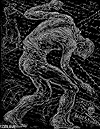Name: Richard Grune
Date of Birth: August 2, 1903
Place of Birth: Flensburg, Germany
 |
Grune himself was arrested in December 1934, one of 70 men caught in a wave of related denunciations. Under interrogation, Grune admitted to being homosexual. He was held in "protective custody" for five months, then returned to his childhood home on the German–Danish border to stand trial for violating Paragraph 175. In September 1936, Grune was convicted and sentenced to prison for one year and three months, minus time already served in protective custody.
At his release, the Gestapo returned Grune to protective custody, asserting that his sentence had been too lenient. In early October 1937, Grune was sent to the Sachsenhausen concentration camp, where he remained until being transferred to Flossenbürg in early April 1940.
Almost exactly five years later, as American forces approached, Grune escaped the evacuation of the Flossenbürg camp and joined his sister in Kiel. He spent much of the remainder of his life in Spain, but later returned to Kiel, where he died in 1983.
Richard Grune's desire to bring attention to the terror of the concentration camps led to the 1947 publication of a limited–edition portfolio of his lithographs, Passion des XX. Jahrhunderts (Passion of the Twentieth Century). His work generally reflects what he personally experienced at the Sachsenhausen and Flossenbürg concentration camps; some images were based on information from other survivors. The portfolio is among the most important visual recordings of the daily nightmare of the Nazi concentration camps to appear in the immediate postwar years.
          |
Flossenbürg
Sachsenhausen
